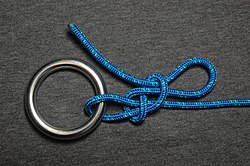| Siberian Hitch | |
|---|---|
 | |
| Names | Siberian Hitch, Evenk knot, Evenk Slippery Figure of Eight Hitch |
| Category | Hitch |
| Related | Halter hitch, Slipped buntline hitch, Highwayman's hitch, Packer's knot, Figure-eight knot, Farrimond friction hitch |
| Releasing | Quick release |
| Typical use | Bushcraft |
The Siberian hitch (or Evenk knot) is a hitch knot used to attach a rope to an object. It is a type of slipped figure-eight noose. The hitch is known for having a tying method suitable even while wearing heavy gloves or mittens in cold climates. As a slipped knot it can be released simply by pulling the working end of the rope.